Prepare to gape in awe when walking any street between Albemarle and Beverley Roads and Stratford Road and East 19th Street. You’ll find huge Victorian mansions of every conceivable size, color and style in these streets. This is no mere accident: one region, known as Prospect Park South, was developed by Syracusan Dean Alvord, who purchased a parcel of land in Flatbush from the estate of Luther Voorhies and the Dutch Reformed Church in 1898. Unlike developers like Alfred Treadway White, who built Cobble Hill’s Workingmen’s Cottages, Alvord from the start built sumptuously-appointed buildings for the well-to-do. By 1898 Flatbush had evolved into a well-established community that boasted good schools, decent local transit (trolleys) and the Brooklyn Rapid Transit Company offered easy transport to Manhattan via the Brooklyn Bridge. Prospect Park bordered nearby to the north.
Alvord’s idea was to extend Prospect Park South and adapt it to residential use. He foresightedly buried utility lines underground and paved the streets in an age when many were still dirt roads or Belgian-bricked. Streets were given British-sounding names for an aura of sophistication, and brick fence posts bearing the interlocking Prospect Park South monogram can still be seen on many intersections.
At around the same time, developer T(homas) B(enton) Ackerson was developing Beverley Squares East and West, between Beverley and Cortelyou Roads, Coney Island Avenue and East 19th, divided between East and West by what was originally the surface Brighton Beach Railroad but today is the BMT Brighton Line (B, Q trains). Ackerson bought ten acres for $85K from the Lott family and hired architects such as John J. Petit, A. White Pierce, J.A. Davidson and Benjamin Dreisler, who had worked with Alvord and also Lewis Pounds, the developer of nearby Ditmas Park and Ditmas Park West. The venture was wildly successful and most of the beautifully eclectic buildings have been meticulously maintained for over a century.
Only parts of the entire region have been landmarked — Prospect Park South and Ditmas Park have, but not the Beverley Squares.
Here are just a few buildings and other notable features from this wondrous area.
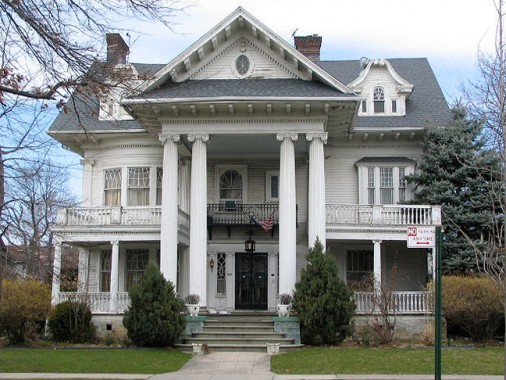
1305 Albemarle Road. The homes along Albemarle Road tend to be palatial and roomy. 1305 was built in 1905 and is dominated by a large entrance porch with 4 tall Ionic columns below an ornamented entablature with a single oval window. The front features two side porches, and the second floor has an iron balcony.
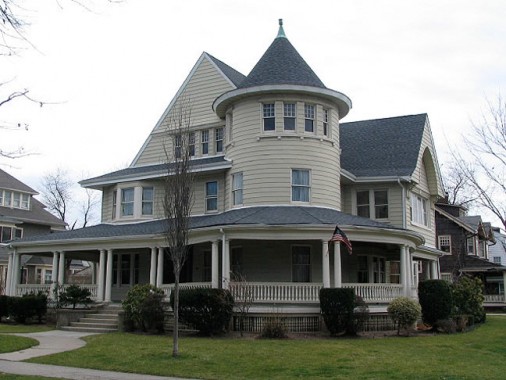
1306 Albemarle Road. John J. Petit, who designed more buildings in Prospect park South than any other architect, designed this corner building features intersecting peaked roofs and a conical turret. The huge, airy front porch wraps around the side. It was first owned by a dye manufacturer, John Eakins.
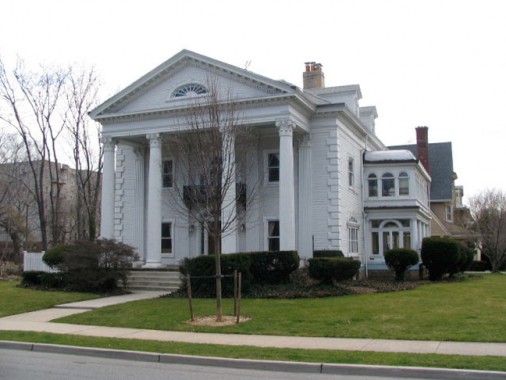
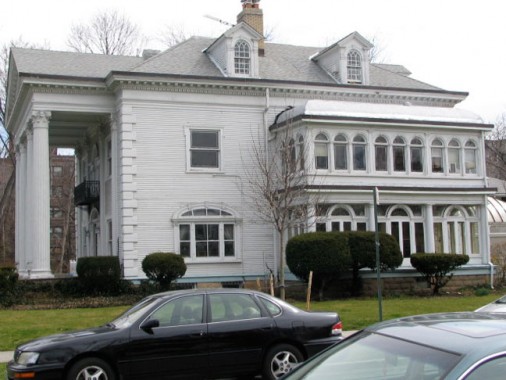
1510 Albemarle Road, corner Marlborough: Built around 1900 with 4 daunting Corinthian columns on a front portico by John J. Petit, but a garage was added in 1910 and the second story on the porch was added in 1920.
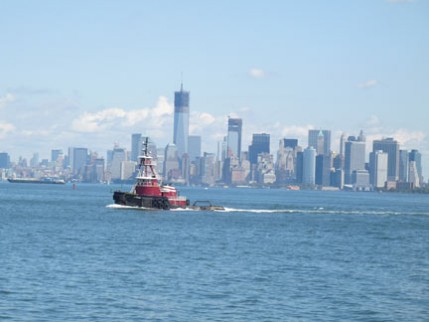 Why show a tugboat in Upper New York Bay in association with this mansion?
Why show a tugboat in Upper New York Bay in association with this mansion?
This is the Christine McAllister; in 1916, the McAllister family, owners of a major tugboat operation in NY Harbor, purchased it from its original owners, the Mintons. It remained with the McAllister family until 1985.
The story of the McAllisters and their tugboat operations is told on this Irish America page.
An interesting relic of the lands south of Prospect Park are these iron signposts identifying neighborhood streets. They must once have been a great deal more prevalent than they are now, but today only two extant signs remain: at Albemarle and Marlborough, and another at Cortelyou and Argyle (which I have inexplicably have not apparently photographed, but it does show up in a Google Street View shot. There is also an iron post sans sign, at Cortelyou and Rugby.
Here’s a primer on Prospect Park South’s British street names, which take the places of Avenues A, B, C, etc., and the north-south roads, which fill in for East 11th through 15th. Most come from London street names which were in turn named for actual persons or places in the British Isles …
Albemarle: named for a London thoroughfare named for George Monck, the Duke of Albemarle, who aided Charles II’s return to the throne and the restoration of the British monarchy in 1660
Beverl(e)y: there are a number of places named Beverley in Britain, most notably a town in Yorkshire. The name comes from an Old English phrase for “beaver stream.” The name is spelled both with an e before the y, and without, in Brooklyn; west of Flatbush Avenue, it’s mostly Beverley, and east of Flatbush Avenue, it’s mostly Beverly. Even the two subway stations on the BMT and IRT have different spellings.
Stratford: a town and a district in East London, England, in the London Borough of Newham. The etymology is from Old English words for “street” and “ford”, the ford, or crossing, being over the River Lea.
Westminster: the area in central London where Westminster Abbey and the Palace of Westminster are found.
Argyle: from Argyll, a region in western Scotland. The name comes from old Gaelic for “border region of the Gaels.” The familiar argyle pattern found in clothing is derived from the tartan of Clan Campbell, one of the larger Scottish clans, who hailed from Argyll.
Rugby: a market town in Warwickshire, England, located on the River Avon. The name may be Old English for “rook fort,” fort frequented by crows, or a Celtic term meaning ‘wild hilltop.’ The Rugby School developed a version of football that was influential in the development of American football.
Marlborough: there are a number of places called Marlborough in Britain, the foremost being a market town in Wiltshire. According to legend it is the burial place of Merlin, the Arthurian magician, from which it takes its name.
Buckingham: a town in north Buckinghamshire, England, close to the borders of Northamptonshire and Oxfordshire. The name means “Bucca’s Meadow,” after an Anglo-Saxon chieftain. Buckingham Palace, the residence of the monarch, was built in Westminster in 1705 by the Duke of Buckingham.
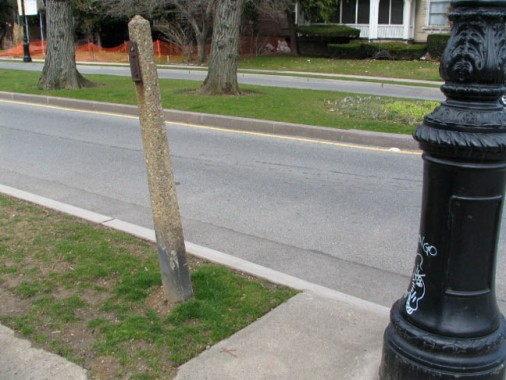
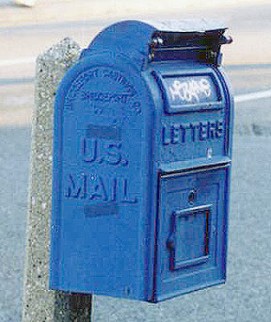 Another anomaly at Albemarle and Marlborough is the presence of a concrete post once used to hold a slot mailbox. They once populated NYC streets by the thousands, attached to concrete posts or telephone poles, and their numbers had dwindled down to a precious few by the time FNY got started in 1998.
Another anomaly at Albemarle and Marlborough is the presence of a concrete post once used to hold a slot mailbox. They once populated NYC streets by the thousands, attached to concrete posts or telephone poles, and their numbers had dwindled down to a precious few by the time FNY got started in 1998.
The last one on a concrete post I have seen was this one on Hillside Avenue and 268th Street in Floral Park, Queens. No slot mailboxes remain in service in NYC, to my knowledge.

100 Rugby Road, swiss chalet built by Architect John J. Petit in 1900 for Dr. George Watson. The master bathroom features a marble bathtub lit by a crystal chandelier.

101 Rugby Road, built in 1900 by architect John E. Nitchie for Colonel Alexander Bacon, a direct descendant of Sir Francis Bacon, the famed Shakesperean-era British philosopher and author. The downstairs living room was used as a museum to display Sir Francis’ armor, mace, shield and other effects. After the Bacons moved out in 1956, the historic items were moved to a Boston museum. Colonel Bacon was West Point-trained Civil War officer who was elected to the NY State Legislature in 1887 and in that post, investigated political corruption.
The house’s greatest claim to fame is its use in the 1982 Kevin Kline/Meryl Streep film about a Holocaust survivor, Sophie’s Choice, for which Streep won the Academy Award for Best Actress. The building sported a pink paint job at that time. Only the exterior of the building was used in filming.
Montrose Morris has more at Brownstoner.

85 Westminster Road, a combination Greek temple and Queen Anne from 1908 by architect George Showers. Many Queen Anne houses are marked by a general asymmetry, so there’s a large 3-columned portico, a corner tower and a dormer on the side. Once again a porch wraps around the side.
Most cross streets in Prospect Park South feature brick and concrete gateposts, complete with the PPS trigram and street identifications. They all have a “v” in them for “u”, imitating the Roman practice of carving the “U” as a “V”. This seems to impart a sense of gravity and importance these days, but in the Roman era, it was just done to save time. The Romans had only the letter U, which they carved as V’s, a letter, along with W, which would only be invented in the medieval era; u’s and v’s were written with u’s, and use dictated pronunciation. (The Romans didn’t have minuscule letters or punctuation, either.)
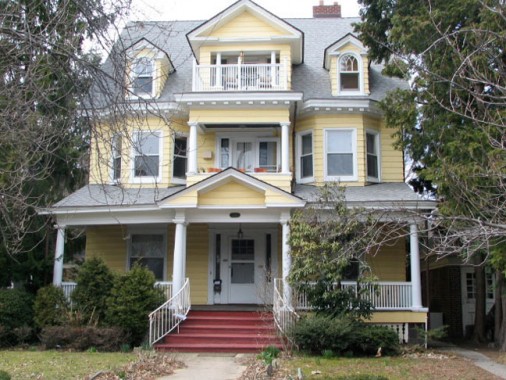
126 Westminster, displaying pastel yellow, one of my favorite colors in houses. This house was finished in 1902 by architect Carroll Pratt, who also designed the Prospect Park Tennis House and Boathouse. It was originally occupied by William Ammerman, an employee of Abraham & Straus.
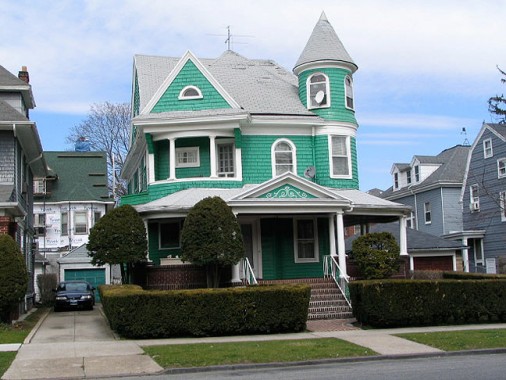
1205 Beverley Road was finished around 1900 by architect Henry A. Sturak, in an asymmetrical style, with bays, oriels, tower, porch and open loggia on the 2nd floor.
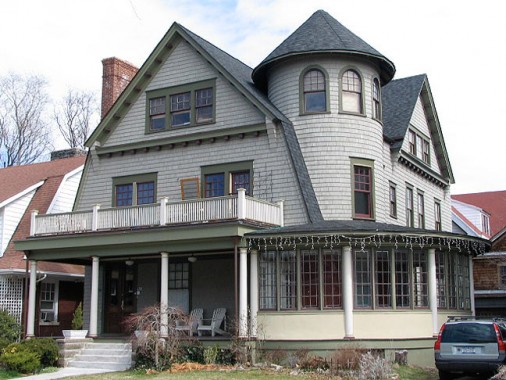
155 Argyle Road was designed by George Showers in 1906. It has an open as well as an enclosed porch, a New Englans style gambrel roof and a corner tower.
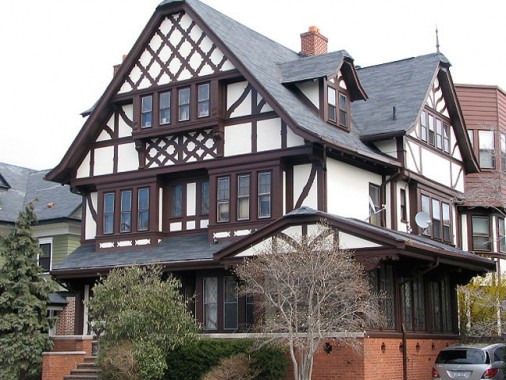
183 Argyle is one of the largest Tudor-style buildings in Prospect Park South. It is another design by Petit. The original owner was electrical engineer and inventor Hubert Kratz, who developed a Paterson, NJ neighborhood he called Prospect Park in honor of his beloved Brooklyn park.
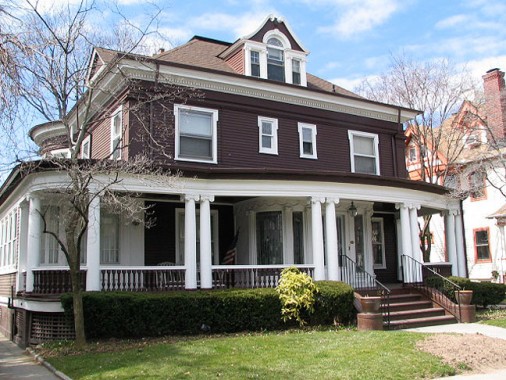
Another house with a magnificent porch with single and double Ionic columns, 154 Rugby Road is another Petit design from 1900.

210 Rugby boasts another Ionic-columned porch and a round tower with a conical apex, designed in 1910 by J. L. Tillack. An early resident was the Howard family, who owned a fleet of tugs and barges that moved coal from Baltimore to New York and Boston. Shipping was monitored via a radio set in the ground floor office.
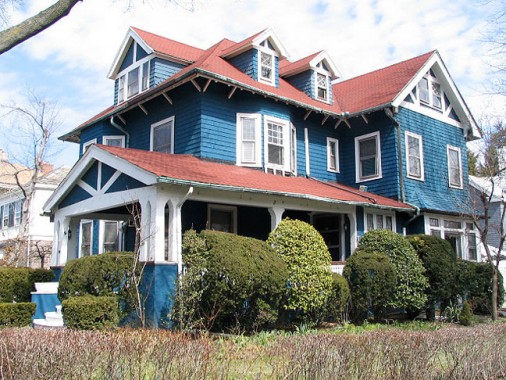
219 Rugby, off Beverley, features a long arched porch with a gable extending along Beverley, a bay window and peaks and dormers at the roof line. It is another Petit design.
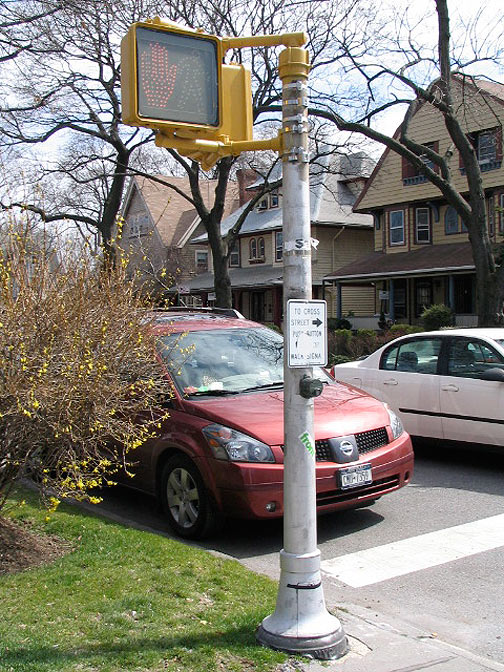
At the corner of Beverley and Rugby is a pedestrian control walk signal mounted on a 1950s cylindrical post. These style posts had fluted bases in the 50s before switching to rectangular ones in the 1960s.
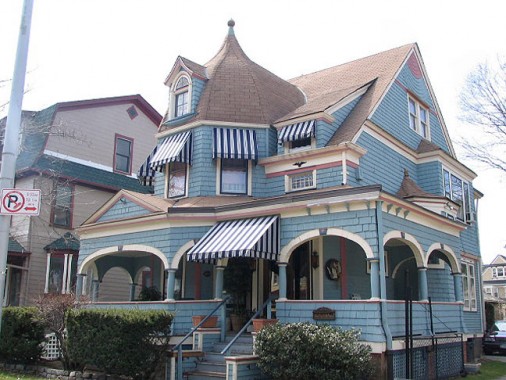
Going further south into Beverley Square West, 242 Rugby Road:
This is one of the cutest and most imaginative houses in Beverley Square. It’s a late Queen Anne gem with a wonderfully arched, wrap around porch, supported by thick columns, and a tower and turret that burst forth from the body of the house, which is clad in shingles and clapboard. There’s stained glass and patterned shingles, dormers and gables popping out everywhere, all emphasized by the canvas shades. You can’t help but smile when you see this building. Landmark it and its neighbors before it’s too late, please! Montrose Morris, Brownstoner
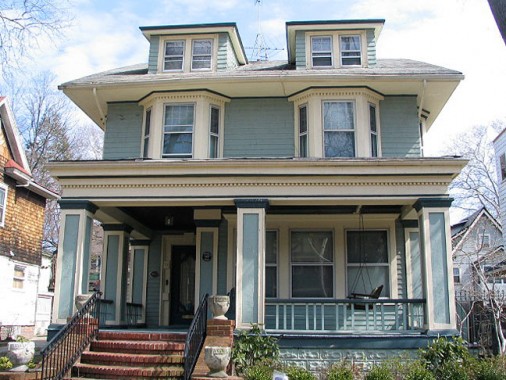
At 305 Rugby is a “honeymoon cottage built for one of the Guggenheim sisters,” as the 2008 Guide to Victorian Flatbush describes it. Inside there is an octagonal library paneled in cherrywood and a built-in bookcase with leaded glass doors.
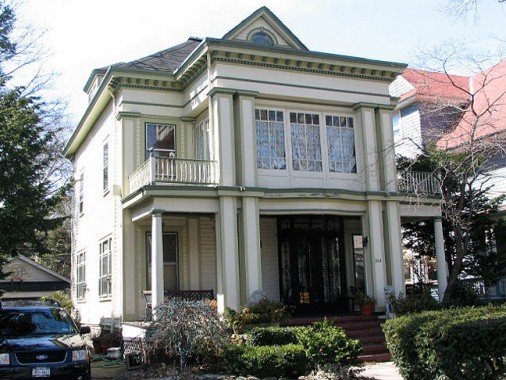
304 Marlborough Road was the home of Beverley Park developer T.B. Ackerson. In addition to the ground floor porch, there’s an enclosed porch over the entrance.
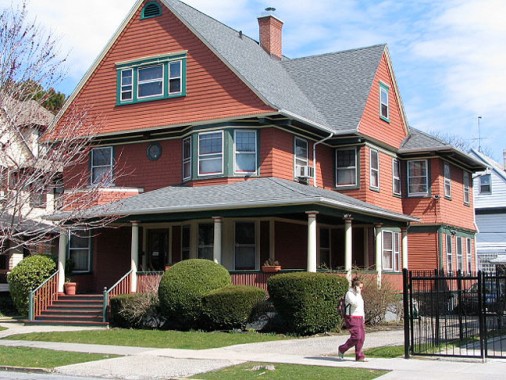
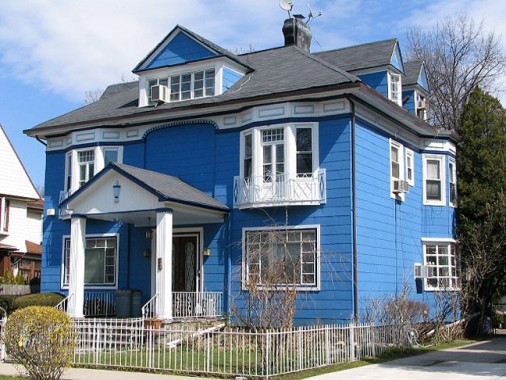
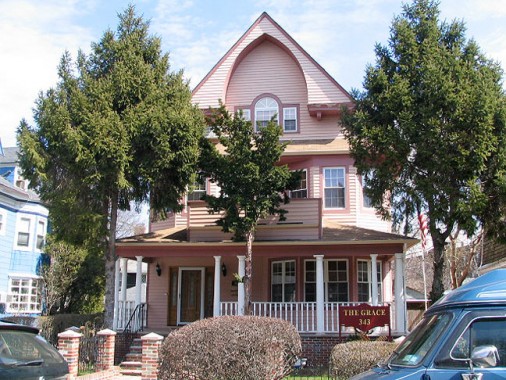
Across the Brighton Line into Beverley Square East, 317, 335, 343 East 17th. Many of the buildings in Beverly Square and nearby Ditmas Park were developed by Lewis Pounds. 317, at the top, was Pounds’ home. He later became Commissioner of Public Works and borough president of Brooklyn, the only Republican who ever served in that office.
According to the above linked article, when originally built, these homes sold in the neighborhood of $8,500. Today, despite the real estate slump that began in 2008, many are worth $1 million.
There are plenty of other eclectic houses to be seen in PPS, the Beverley Squares, Ditmas Park, Midwood Park and Fiske Terrace and I hope to show more soon. In the meantime I also shambled down Cortelyou Road, the main shopping and restaurant district serving the various south of Prospect Park neighborhoods. Oddly there is no main north-south avenue with stores or restaurants until you get to Flatbush Avenue: Coney Island Avenue, originally a plank road and then a major trolley route, is mostly nondescript, with a couple of exceptions.
Cortelyou is a Dutch name in a sea of British names; Jacques Cortelyou arrived in New Netherland in the 1650s as a private tutor to the children of Cornelius Van Wreckhoven, but when his boss died unexpectedly, Cortelyou became the manager of his holdings in Flatbush. He named the western end of the holdings Nieuw Utrecht in honor of the Dutch city. The Cortelyou family held property in Brooklyn into the 20th Century.
Though the name appears as if it’s pronounced KOR-t’l you, Brooklynites invariably pronounce it Kor-TELL-you.
I was going to go into a treatise on Cortelyou Road on this page, but it turns out I already have, in December 2009. But here are a couple of things left out there:
I always liked Cortelyou Road’s collection of identification signs, in florid, 1890s-style typography. They have apparently been here since 1985 and were apparently installed by the NYS Division of Housing and Community Renewal. The agency, formed in 1926, oversees all public and publicly assisted housing for both the city and the state of New York. It also performs development planning and community preservation, administers state and federal loans to developers building low-cost housing, and manages the rent-control process for New York City apartments.
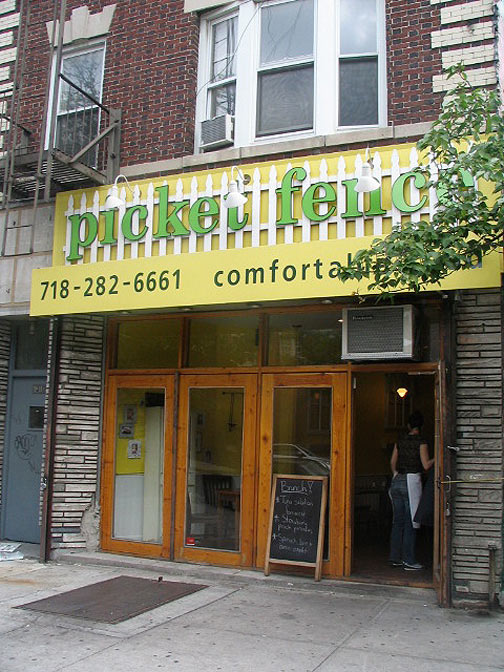
Cotelyou has become a restaurant locus in recent years. When I’m with folks in the area I usually find myself in Picket Fence, which sells American comfort food, my favorite type. Still, you have to get in before 3PM on the weekend, since they switch from a brunch to dinner menu at that time. Nice sign in Century Schoolbook.
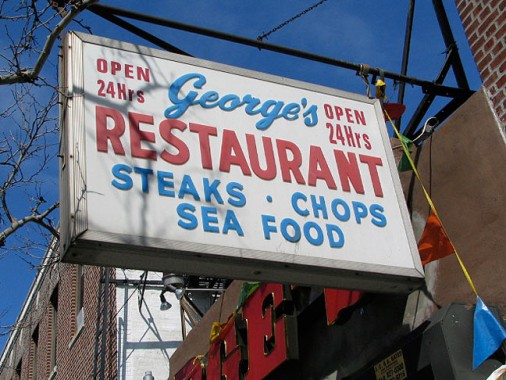
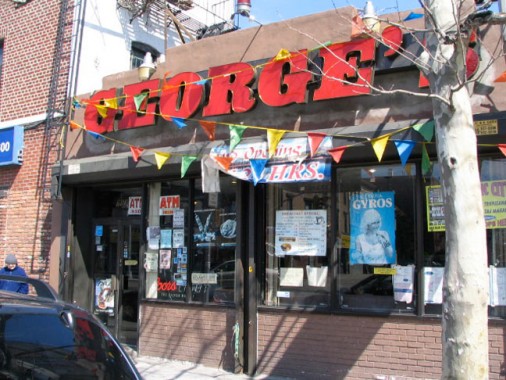
There’s the neighborhood standby, George’s, on Coney Island Avenue, which I have known about since the 1980s when the area was considerably grittier than it is today. And nice use of Egyptian Bold on the sign.
Source: Prospect Park South: A History, Edith Roberts Langenau
2/17/13

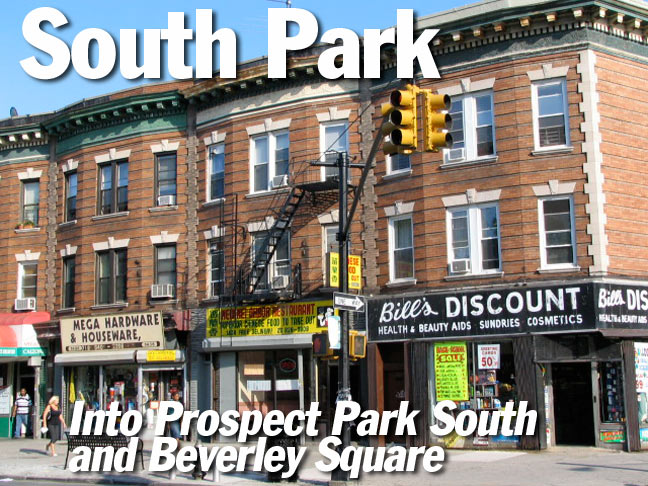
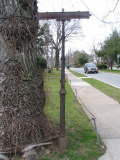
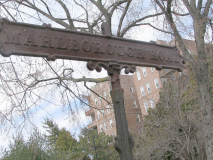

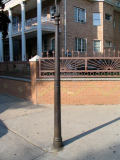
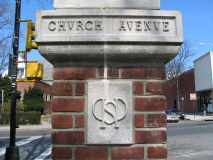
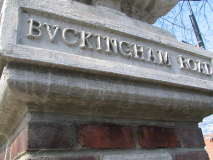
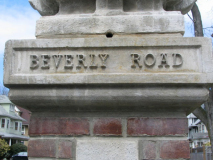
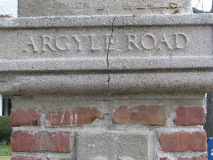
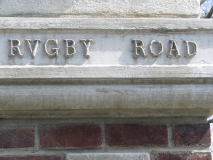
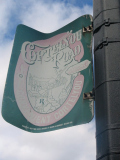
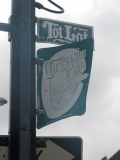
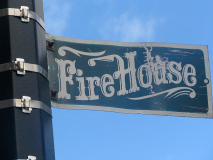
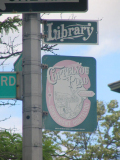
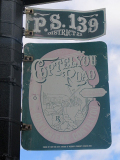
30 comments
I was born and raised in Brooklyn. We had at least ten changes of address by the time I left for college and returned only during semester breaks and summer. I remember living on Cortelyou Rd just south of Flatbush Ave and again just south of Ditmas. I attended P.S. 139. I also live on Coney Island Ave just off Cortelyou Rd. I lived on Ocean Ave between Newkirk and Foster. I lived on 19th St north of 8th Ave twice. I lived on Sacket St twice between 4th and 5th Ave. I also lived on 5th Ave between Douglas and Degraw. I remember living on Patchen Ave. There’s a couple more that I can’t recall. And by the way, you missed mentioning the Laffayete home in Prospect Park. In those days we lived one step ahead of the landlord, so the saying goes.
It’s possible, even probable, that Stratford Road was named after Stratford-on-Avon, the birthplace of Shakespeare. In the 1890s Stratford in London was a very insignificant place.
Awesome houses!!!
Beautiful. They don’t build ’em like that anymore.
Back in the “bad old days” for NYC during the late ’60’s and ’70’s, I used to take the subway to my dermatologist in this area. Even then, before I even knew I was a fan of architecture, I remember being so impressed by these homes as I walked from my subway station to the Dr.’s office. My dad had told me that at the time many were owned by doctors and prestigious judges and other high ranking government officials. I am glad to see so many of these homes have been maintained and restored. Alas, I fear the creeping crud that is taking over Queens will eventually discover that they can buy and tear down these homes to put up a Fedders Specials or turn one of them into a butt-ugly “modern” monstrosity. I hope these homes do get landmarked.
You probably are referring to Dr. Frank, a dermatologist who lived and practiced in a grand old house at the corner of Argyle and Albemarle Roads. He had two separate addresses on the two roads, one for his residence and one for his practice. My wife worked for him for a few years. I recall coming by one day, finding Dr. Frank doctor tinkering with a crystal doorknob that had broken. He said to me that these types of knobs can’t be had or fixed anymore.
Wow. Dr. Frank sounds familiar. It was a long time ago and, strange as it seems, I remember the cross streets you named more clearly than the Dr.’s name! I used to take the subway from Franklin Ave to Beverly Rd and walk the couple of blocks to the Doc’s office. I digitally walked the route on Google Maps. Though I don’t remember any specific houses, my impression is that the neighborhood is little changed from when I walked it in the “analog” world decades ago. Nice to see that, oddly enough, there is still a true suburban and beautiful Victorian community still thriving in Brooklyn. It’s my town!
I agree about preserving this beauty. Once it’s gone, it’s gone. Where I live in Bay Ridge near the Verrazano Bridge I see these homes torn down every week in the 80s and 90s. So sad.
Even though this area is very distinctive, I still see a lot of websites associating Prospect Park South as part of Ditmas Park.
I lived in that part of Flatbush from 1953 – 1975 and went to PS 139.
To the east of 1510 Albemarle Road, there is currently an empty lot. I used to “explore” in that lot. because a house had burnt down there in the mid 50’s. It was the “Exlax Estate” and can be seen (largest dark house in the lower middle of the right hand frame) in this 1907 aerial view from the Library of Congress: http://www.loc.gov/pictures/item/2007663906/
That lot used to be the home of PPS developer Dean Alvord.
I think the empty lot is now a wonder community garden. And it’s still fun to explore.
I’ve even heard it pronounced, by people possibly not from Brooklyn originally, as something approximating “Cordelia Road.” It makes a certain amount of sense, I suppose, if you say the unfamiliar “Cortelyou” fast.
Unbelievably beautiful. I love Brooklyn. We have it all here.
I never understood why the streets here are named after places in both England and Scotland. Was whoever thought of those roads happened to be from the UK or just happened to be modeled after them? Just noticing those names does make me feel curious about them. Then again, maybe those streets were already there before the houses came and go back to colonial times, but I am just guessing here.
There is still a slot mail box in use at the Richmondtown Restoration in Staten Island.
Stratford, Westminster, Argyle, Rugby, Marlborough: the first letters were SWARM. We were told that there had been bee farms there.
I grew up on Argyle and Cortelyou. If you went to PS 139, there’s a great Facebook group: “Old School Cortelyou.”
That was were I was a kid. Nice to see some of the houses again. Remembering the old days. LOL makes me think I’M OLD. Thanks for the walk down memory lane. I lived on Stratford Rd. and Albemarle Rd.
[…] house is a whimsical structure honored by its residents. It’s been featured on Brownstoner, Forgotten NY, and in The New York Times as a prime example of Victorian Flatbush architecture. Billy has kept […]
This is my neighborhood , although I live on the other side of the tracks going into East 16th and 17th streets. I just finished walking around there LOL. I’m 29 yrs old btw but very much know the history of my neighborhood. Anyway, back then there used to be a bridge connecting Albemarle Road going over the train tracks connecting to the two sides together. The other side would be the dead end of Albemarle Road and East 17th, my block. You can still see the large concrete stones where the bridge would be connected. I’m not sure when it was taken down but I believe it was sometime between the late 70’s to early 80’s. Some locals I’ve talked to say the bridge might’ve been taken down because the police would have a tough time catching those who committed crimes because they’d simply run across the bridge and escape through the other side. Overall these plots of land are all beautiful but lets not forget who the area entirely belonged to, the natives of this land of course. Also, Cortelyou has changed drastically over the past 15 years. To be honest none of these new stores and restaurants like the Picket Fence really cater to the originals of this community but more so to the newcomers who call my neighborhood home now.
Hi Kevin,
Great website and article, brother. I grew up in the neighborhood, which we knew only as Flatbush. No Prospect Park South or Ditmas Park West. Only as our beloved Flatbush. I lived at 391 Rugby Road, between Cortelyou (pronounced locally as Coor-TELL-you) and Dorchester Roads from March 1961 to September 1989. Our old home is presently owned by the very nice Fischer Family… who once told me back in 2001 that they STILL got mail for me there.
We used to take a hike as kids up to “the little park” located at 1522 Albemarle Road, an empty lot that was once the site of Dean Alvord’s Tudor-style home, a magnificent L-shaped residence based on the pictures I saw of it. Alvord was the mastermind of the development of the areas known as Ditmas Park and Prospect Park South.
He sold the property to Israel Matz, president of Ex-Lax, who lived there until his passing in 1950. The family members who had inherited the property wanted to sell it to an apartment house developer, but the upper crust neighborhood went up in arms over it. The home was basically empty for years and eventually became vandalized. In 1958, it was burned completely to the ground. It became an empty lot, overgrown with trees, weeds and bushes. We used to (like my former Flatbush fellow Bruce Rubinstein) play games there for hours. A piece of forest in the heart of a Flatbush enclave.
The property was eventually fenced in by the neighborhood and we had to scale it to get into our little park while my Dad and our dog Banshee would sit on the steps of the old footbridge that crossed the BMT line connecting Albemarle Road; the footbridge was removed thanks to pressure from this wealthy neighborhood because it was used as an escape route for muggers, purse snatchers and burglars in the 1970s.
It was given to Downstate Medical Center in 1978 by the Matz family and sold at a nominal fee to someone in the neighborhood not too long ago. It is now going to be a communal garden, which is a rather nice idea.
I miss my old neighborhood, but I can remember the bad old days of white flight in the late 1970s and 1980s, crack epidemics, armed robberies, purse snatchings of my Mom, my Dad’s car being stolen the night before he had to take Mom to chemotherapy, burglaries, and several of the great old homes of the community being neglected and falling apart.
Next door to the old lot was the famous McAllister Manison at 1510 Albemarle Road, a tugboat magnate who bought the white-columned mansion in 1916 from the Mintons, who bought it in 1905. The home was designed and built by architect John J. Petit. The McAllisters moved out in 1985.
It seems like there has been quite the renaissance in the old neighborhood. I am glad for it, and look forward to some day returning for a visit, and enjoying a pint or two at The Sycamore or the Bar Chord, new drinking establishments in the prospering community.
Happy Holidays, all!
Sincerely,
Denis McGowan
Good to hear from you Denis.
I grew up on Rugby Road. My parents purchased the house in 1946 and was sold after my father’s death in 1970. It was a great area and we played ball in the street along with roller hockey. The lasrge “ExLax” house was was still there but the estate was auctioned off in the 1950s. Later the house burned down and the lot was empty. The best part of the neighborhood were the small merchants on Church Avenue, butchers, bakeries, candy stores, etc. Great memories.
I am interested in viewing 305 Rugby Rd and possibly two others, I am Gloria A Williams of Williams Investment corp, I am seeking a home to reside. Please Email@gloriaa2@gmail.com, with info. Thank You ! Gloria A Williams Owner,
good images
thanks
yours
Arvind
Edith Roberts Langenau who you credit in your post was my great aunt. Thank you for posting such great photos. She lived on Marlborough with the Langenaus. I would love to see their house today. Thank you for crediting her work in your post. The homes are still stunning!
Delived the Brooklyn Eagle to most of the houses in the post. My route ran from Foster ave to Beverly Rd. ,13th to 19 St back in the middle to late 40s. We lived on Newkirk Between 15th and 16th St.
My parents bought 238 Argyle Rd. between Beverly and Cortelyou in 1954, the year I was born. My mother sold the house in 2005. It was a great neighborhood to grow up in.
We lived at 310 Argyle Rd,between Beverley and Cortelyou Rd,directly across the street from PS 139. Your name sounds familiar. Our family of 9 children, lived there till 1979,the Lacovara Family. We all went to kindergarten at the Cortelyou School,and then to Holy Innocents School, on East 17 th Street and Beverly Rd.
Grew up in a Dutch Colonial Victorian on E. 21 St. between Glenwood and Farragut Roads in Victorian Flatbush. My parents owned the home from 1970 until 2004. In that 34 years, we watched the neighborhood gentrify and change remarkably. Right near the campus of Brooklyn College, my parents were English professors. I went to Edward R. Murrow high school, graduating in 1991. I moved up to Amherst, Massachusetts to attend college, and then came back to live in Brooklyn from 1999-2004 while I attended grad school in Manhattan. I now live in Northern California, but I will always be a Brooklyn boy at heart. Those houses and neighborhoods are truly unique: they are like NOWHERE else in the entire country.